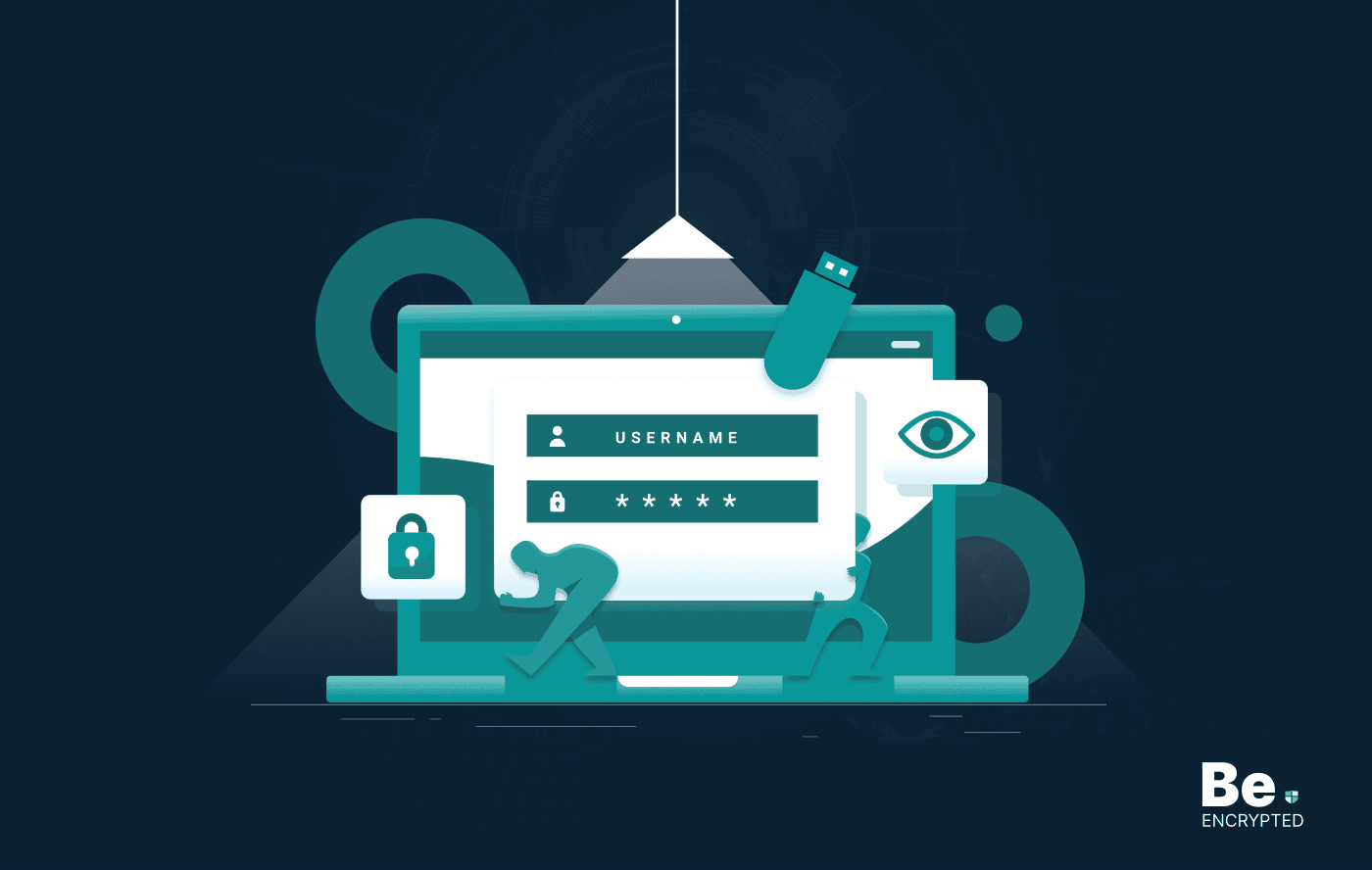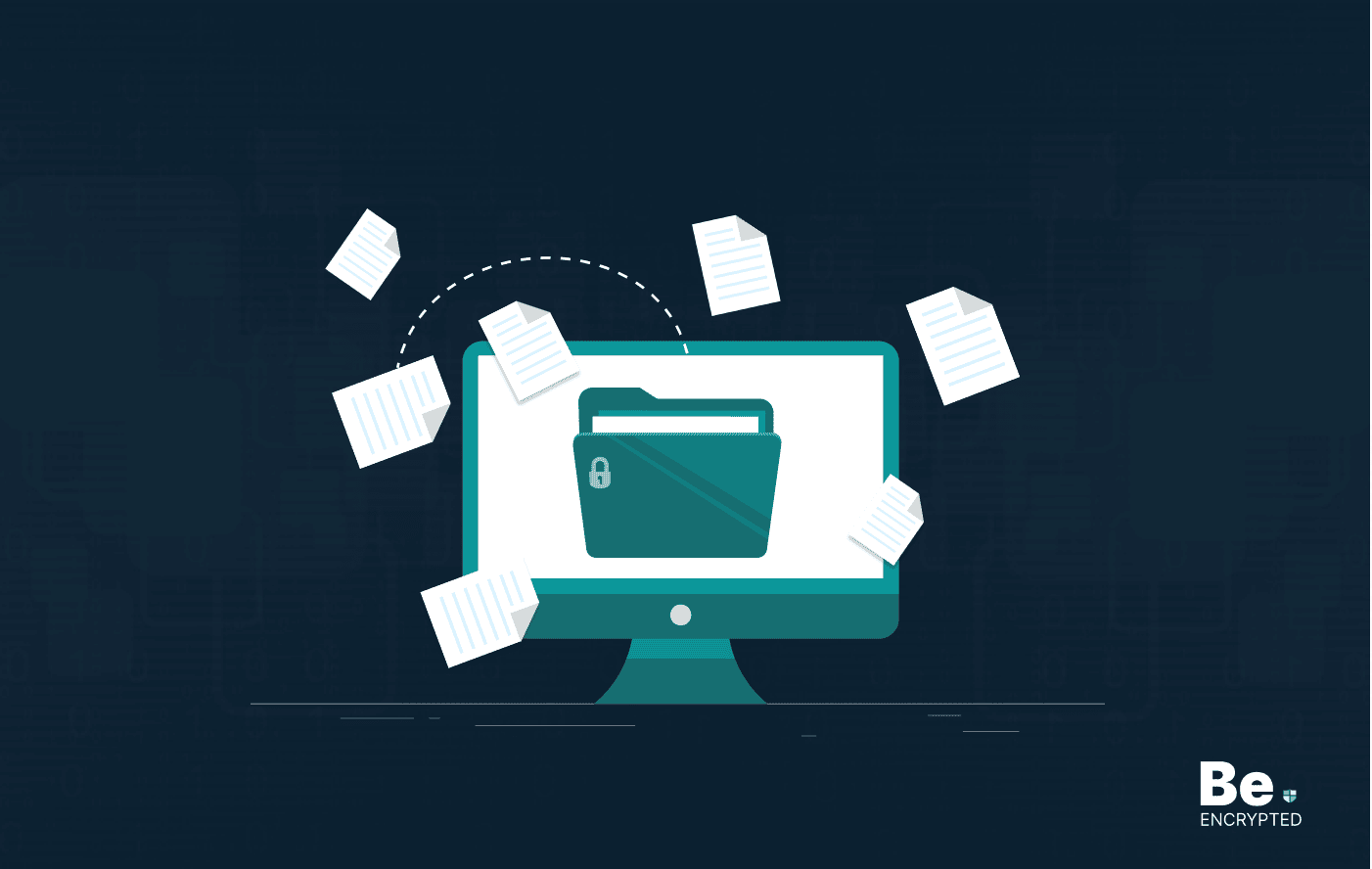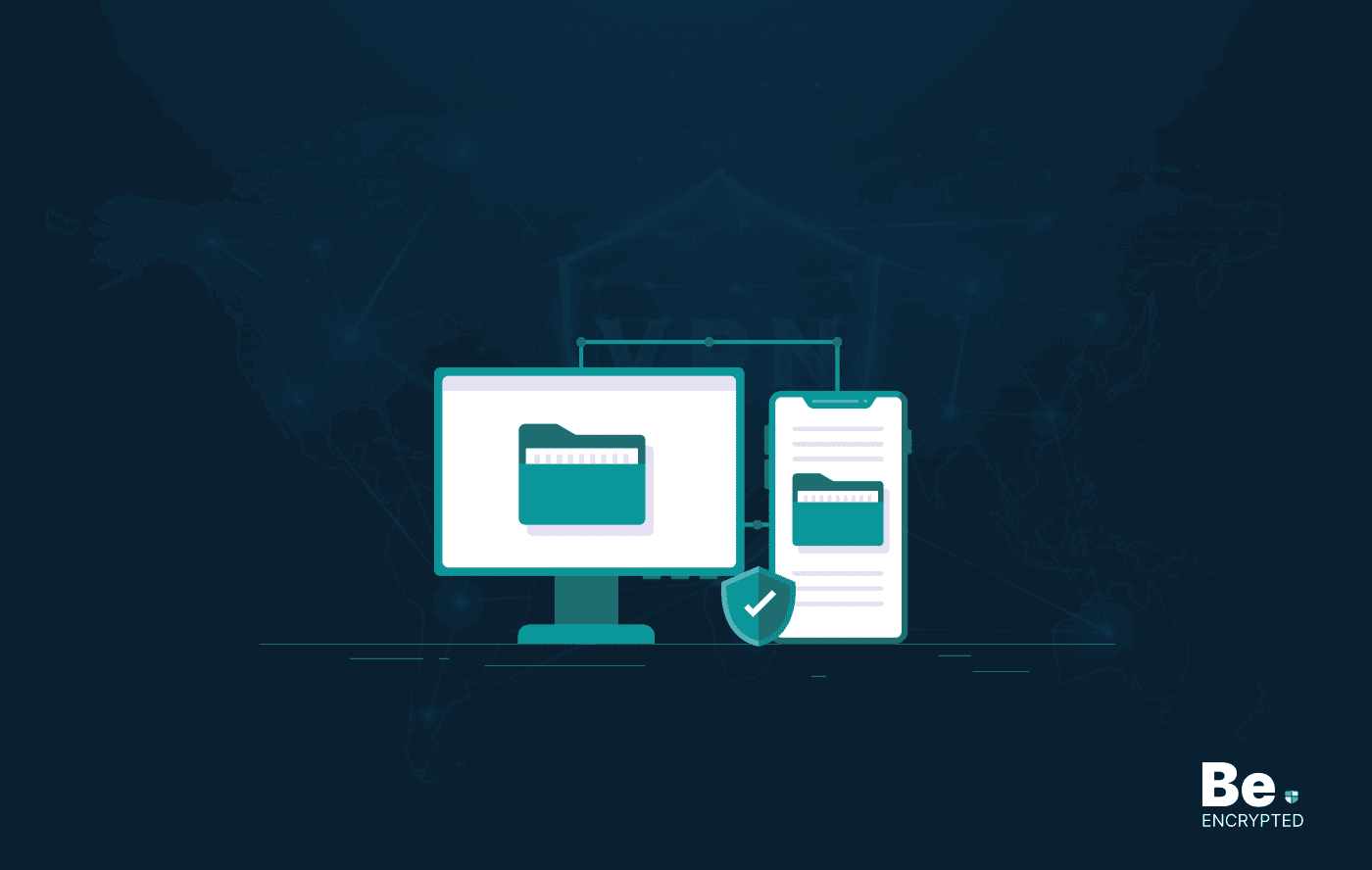Our data is of particular importance to the government and cybercriminals alike. While cybercriminals tend to acquire this data through unlawful means such as hack attacks, malware invasions, or phishing attacks, the government tracks you through your ISPs.
Along with that are the advertisers who fervently steal our information through cookies and trackers. There is no hesitation in saying that our online presence is under constant vigilance. Therefore, it is crucial to ensure data protection, and the best possible way to do that is simply to encrypt your data.
What is data encryption
Data encryption is a process that helps us protect data by converting it into data into an unreadable format using different devices and techniques. The converted text is known as “ciphertext,” which ensures data integrity. The ciphertext is transformed into a readable format through a decryption key. Ciphers can be of many types, like block ciphers that convert text into a fixed-sized message, stream ciphers that generate a continuous stream of symbols, etc.
Converting data into ciphertext, accessible only through a specific decryption key, ensures data integrity. Since the data is converted into an unreadable format with encryption, it eliminates the chances of data snooping or data theft.
Data encryption remains a reliable form of data storage and transport. It works as an extra layer of security when transmitting your confidential data. It can increase the security level of individual files, devices, machines, or hard disks and protect them from counterfeit activities, attacks, or malicious actors.
The encryption key is a complex series of numbers jumbled in a specific way. The length of the key determines its strength. The larger the size of the key, the harder it is to hack. Unraveling a key that is a very complex series of numbers, e.g., 128 bits to 256 bits, will be a tactical task to decrypt a message.
The following are the main types of data encryption:
Symmetric encryption
In symmetric data encryption, the private password is used to encrypt and decrypt data. The communities using symmetric encryption should share the key so that it can be used for decrypting data. Symmetric encryption is an ancient but unique method of encryption, and it is much more efficient and performs faster than asymmetric encryption.
Symmetric encryption is used for encrypting bulk data or massive data, such as database encryption, because of its better feat. If you use symmetric encryption for your database, you should keep a secret key or password available to the database for encryption or decryption.
Examples of symmetric encryption are transactions via credit or debit cards, OTP verifications, or hashing.
Asymmetric encryption
In asymmetric encryption, one public and one private key or pair of keys are used for data encryption and decryption to protect data from an unwanted person. A cryptographic key is a public key that a sender or any person uses to encrypt a message so that the receiver can only decrypt it with his private key.
A private key is only known as a secret decryption between the key initiator and a receiver. This process can happen and vice versa. The sender can use a private key, and receivers may have a public key to authenticate the sender. The critical point is that you don’t have to physically lock and unlock messages.
Asymmetric encryption is used in encrypted emails, cryptocurrencies, and browsers to verify e-signatures and digital signatures or establish a secure network connection. TLS stands for transport layer security, and SSL stands for secure sockets layer, mainly depending on asymmetric encryption.
Public key infrastructure
PKI, mostly known as public critical infrastructure, is the framework used for data encryption in cybersecurity. It allows protected communication between the server and the client. Here, the server is the sender, and the client is the receiver, which can be your website and the user. It performs encryption straightly with the keys it generates, where one is a public key and the second is a private one.
The three main components of the public critical infrastructure are digital certificates, certificate authority, and registry authority. All these play an essential role in verifying the identities of machines and their owners performing transactions to protect data from attacks and maintain security.
PKI resolves a challenge. The key belongs to the same person who received the key by verifying the identity of people, machines, and applications used for encryption and decryption using digital certificates. So, no chance encrypted messages can be decrypted or received by the person sitting as the “man of the middle.”
What are the most secure encryption algorithms?
Users can choose several data encryption algorithms depending on their use case. However, the most popular algorithms are ECC, AES, Twofish, and Triple DES. The essential mathematical properties these algorithms use to generate public and private keys are RSA, ECC, and Diffie-Hellman.
Some of the best encryption algorithms are:
AES encryption
AES is an iterative cipher based on a “substitution–permutation network.”It includes three block ciphers.
AES-128
In AES-128 encryption, a key of 128-bit length is used to encrypt or decrypt a specific chain/block of messages. In this encryption, 128 bits of plain text are treated as 16 bytes, divided into four columns and four rows, which form a matrix. It is around the size of 10 numerics.
AES-192
In AES-192 encryption, a key of 192-bit length is used to encrypt or decrypt a specific chain/block of messages. This encryption treats 128 bits of plain text as 24 bytes. It is around the size 12.
AES-256
In AES-256 encryption, a key of 1256-bit length is used to encrypt or decrypt a particular chain/block of messages. This encryption treats 128 bits of plain text as 32 bytes. It is around the size of 14.
Process:
Every round of AES has four strategies:
- SubBytes: Input bytes are divided into rows and columns to form a matrix
- Shift rows: Each row is shifted to the left, and if any entry “falls off,” it is inserted again onto the right side of the row.
- Mix columns: Each column is transformed using a mathematical function, which creates a new matrix of the same number of bytes.
- Around key: In this round, the subkey is combined with the state. And if it is the last round, the text is converted into ciphertext.
So far, the AES encryption algorithm is known to be the safest encryption method. It is popularly used by VPNs and other privacy and security tools to ensure secure data transmission. While it is not impossible to crack AES encryption, breaking it is complex.
RSA encryption
RSA is an asymmetric encryption algorithm. At first, only one key was used for the encryption and decryption. Anyone with the key could access that message, but due to RSA encryption, there are two keys: public and private. The public key can encrypt the message, but only the private key decrypts the messages. This has made encryption and decryption a lot more secure.
RSA encryption uses prime numbers. Different concepts, including trapdoor functions, prime generators, and Carmichael’s totient function, can generate public and private keys.
TLS encryption
TLS is a widely used security protocol. It evolved from Secure Socket Layers (SSL) to secure web sessions, initially developed by Netscape Communications Corporation in 1994. it was mainly designed to carry out secure communications over the Internet. TLS is now primarily used in encrypting communication between web applications and servers, such as a web browser loading a website would use TLS encryption. It is also used for other communications, such as email messaging and voice-over IP.
The protocol combines symmetric and asymmetric cryptography, providing increased data transfer security. A session key is generated and exchanged using asymmetric cryptography. That session key encrypts the data sent by one end and decrypts the data received by the other. After this use, the session key is discarded. It ensures a secure transfer of data between both ends.
WPA3 encryption
Wi-Fi-protected access 3 is a security program to protect wireless systems. It is the latest and updated implementation of WPA2 and was developed by the Wi-Fi Alliance. WPA3 has two modes:
WPA3-Enterprise
It uses different methods to ensure protection.
- Authentication: Multiple Extensible Authentication Protocol (EAP) methods
- Authenticated encryption: Minimum 128-bit Advanced Encryption Standard Counter Mode with Cipher Block Chaining Message Authentication (AES-CCMP 128)
- Key derivation and confirmation: Minimum 256-bit Hashed Message Authentication Mode (HMAC) with Secure Hash Algorithm (HMAC-SHA256)
- Robust management frame protection: Minimum 128-bit Broadcast/Multicast Integrity Protocol Cipher-based Message Authentication Code (BIP-CMAC-128)
WPA3-Personal
- Natural password selection: Users can choose their password.
- Ease of use: Do not change the procedures of connecting to a network, making it easy to understand.
- Forward secrecy: No matter if the data was transmitted or not, it always provides security to the data traffic.
WPA3 encryption is an essential element for standard wireless security. It provides enhanced security features for enterprises and individuals alike, such as 256-bit Galois/Counter Mode Protocol (GCMP-256), 256-bit Hashed Message Authentication Mode (HMAC), and 256-bit Broadcast/Multicast Integrity Protocol (BIP-GMAC-256). Additionally, it supports security measures such as perfect forward secrecy.
SSL encryption
SSL is an encryption protocol used for Internet-based platforms.SSL encryption works through public-key cryptography. When a user signs in to a website, it asks for the server’s public key in exchange for its own. This public key is then used to encrypt messages. The server then decrypts these messages with a private key. It cannot be opened other than the combination of keys only the server knows.
SSL encryption encrypts data before transferring the data to protect it from interceptions. After this, an authentication process is initiated. This process is called a handshake. It ensures the identity of the devices.
Blowfish
The Blowfish algorithm is a symmetric encryption and block cipher, making it highly secure. It is a fast encryption algorithm that takes a variable-length key, making it accessible for exportation.
Blowfish converts the messages into ciphertext using a specific key. This key takes much more time to generate, making brute-force attacks more difficult. It requires fewer operations, making it fast. It can be used as a password-hashing function in embedded systems, etc. The fact that it does not require any patents makes it accessible for anyone to use.
Encryption protocols
Encrypting data involves the use of specific encryption protocols. Some of the key encryption protocols are as follows:
TLS/SSL
Secure Sockets Layer or SSL is the original name of the protocol developed in 1990 by Netscape. The next version of this protocol was released in 1999 with Transport Layer Security or TLS. Therefore, SSL and TLS are often lumped together as SSL/TLS.
SSL/TLS encryption uses symmetric and asymmetric encryption to ensure secure and private data transit. While Asymmetric encryption allows a secure session between a client and a server, symmetric encryption is used for secure data exchange. Since websites commonly use it, they must have an SSL/TLS certificate for the webserver/domain to use this encryption protocol.
IPsec
IPSec is a group of protocols that allows encrypted communication between devices. It encrypts IP packets and then authenticates the originating source of the packets. Since it enables private communications, it is mainly used within VPNs.
Three main elements make up IPSec, including the Encapsulating Security Payload (ESP) and Authentication Header (AH).
The final aspect of the framework is Security Associations (SA). IPSec uses SAs to establish the parameters of connections. These parameters contain the critical management system parties use to authenticate each other. Encryption algorithms, hashing algorithms, and other elements are also essential to this parameter, which is used to operate a secure and stable connection.
IPSec uses the ESP and the AH protocols for either transport or tunnel mode. When in tunnel mode, the protocols encrypt the entire data packet and authenticate it. At times, these protocols carry out both of these functions.
The original header remains for transport while the new header is added underneath. Any changes are made according to the protocol in use. Both ESP and AH servers protect data packets. When used with VPNs, IPSec commonly uses the ESP protocol for authentication in tunnel mode, allowing VPNs to create encrypted data tunnels.
SSH
Also known as the SSH Secure Shell protocol, the SSH protocol helps ensure secure remote login from one device to the other and secure file transfer. The protocol is typically used within networks to provide secure access to users and automated processes, allow automated file transfer, issue remote commands, and manage network infrastructure.
It works in a client-server model, which means that the SSH client typically forms a connection to the SSH server. The SSH client is the one responsible for driving the connection setup process. It uses public-key cryptography to authenticate the identity of the SSH server. Once the client completes the setup phase, the SSH protocol ensures secure data transfer between the client and server through strong encryption and hashing algorithms.
The SSH secure file transfer protocol is widely used today since it ensures data security and integrity. SSH in networking protects data against overt types of cyberattacks committed by system hijackers. It also protects from subtler information theft, like packet sniffing, by authenticating and encrypting every session.
Wire Guard
This protocol is a communication protocol. It allows open-source software, etc., to work securely. It is commonly used in VPNs.
Wire Guard uses the following encryption algorithm for data security:
- Curve25519 for key exchange
- ChaCha20 for symmetric encryption
- Poly1305 for message authentication codes
- SipHash for hashtable keys
- BLAKE2s for the cryptographic hash function
- UDP-based only
WireGuard employs a mix of ChaCha20 and Poly1305 for encryption and authentication, unlike typical VPN protocols that rely on the AES encryption scheme. It guarantees that you can benefit from protection without putting additional strain on your hardware. WireGuard’s handshake has a 1.5 Round Trip Time.
OpenVPN- TCP/UDP
OpenVPN encryption uses the TCP or the UDP encryption protocol to ensure data security and transfer. The UDP and TCP protocols use the AES encryption cipher for encryption. While they are commonly used together, encryption protocols can also be used differently depending upon the use, as both have slightly different functions.
The TCP protocol is a connection-oriented communication protocol that uses a three-way handshake to establish secure and reliable connections. With TCP, the data can be transmitted in two directions. It has a built-in checker for errors and delivers data in order, making it a reliable protocol for ensuring data transmission. However, a drawback is that it uses greater bandwidths.
In contrast to TCP, the USP is a simple and commotion internet protocol. Also known as User Datagram Protocol, it doesn’t require an error-checking function or recovery services. With UDP, there is a restriction on opening, maintaining, or terminating a connection.
It carries our data transfers even if the receiver doesn’t receive them. While it isn’t ideal for emails or web page viewing, UDP is commonly used in real-time communication, such as broadcast or multi-task network transmission.
Tools for data encryption
While encryption may seem complex, it was initially a simple daily task. Fortunately, there are several tools available for data encryption that you can use. While most of these are free, and some are paid. Let’s take a glimpse at the few best data encryption tools available nowadays:
AxCrypt
It is a reliable tool that protects your file and allows secure file sharing using public-key cryptography. It also has built-in online password storage. The multilingual functionality makes it easy to use for everyone. It also protects files saved on Dropbox or Google Drive using 128-bit or 256-bit AES.
BitLocker
BitLocker is a full-disk encryption tool built into the latest Windows operating system (Windows 10). It uses 128 and 256-bit encryption to encrypt files and data on the drives. You can encrypt a particular drive or an entire hard disk using BitLocker. It’s a built-in feature of Windows that is, by default, integrated into your machines, so you don’t have to install any other encryption tool.
CryptoExpert
CryptoExpert is the most powerful encryption tool, allowing multiple encryption methods. It comes with two-factor authentication. It creates a separate folder for sensitive data, protecting it from cyber-attacks. The tool also secures vaults of various sizes depending on the type. It uses complex algorithms like Cast and 3DES for data encryption.
VeraCrpyt
VeraCrypt is an open-source program that is best for researchers and developers. It can be used on Windows, OS X, and Linux operating systems. It hides encrypted data in the form of volumes, one into another. Many security features and functionalities motivate users to use it for data encryption.
Certain Safe
Certain Safe provides cloud-based data encryption, which mitigates the risks of counterfeit attacks. It allows users to communicate with one another via their system. It also retains the past file versions. The tool is somewhat expensive, but its free trial is available. It has an automated security feature for databases and applications.
Boxcryptor
It provides cloud-focused data and file encryption using RSA and AES 256-bit encryption. All passwords, files, group, and company keys are kept on the user’s device at the exact moment. Its free option is available for two devices only. Boxcrptor’s main feature is allowing encryption across multiple devices.
VPNs
VPNs or virtual private networks are online security and anonymity tools. They ensure data security by encrypting your data and further carrying it within encrypted tunnels. Besides, VPNs also ensure anonymity by rerouting your traffic through remote servers that mask your IP address.
A legitimate VPN uses the secure encryption cipher and protocols to ensure encryption. Some of the best VPNs are ExpressVPN, Surfshark, NordVPN, and ExtremeVPN.
Share this article
About the Author
Rebecca James is an IT consultant with forward thinking approach toward developing IT infrastructures of SMEs. She writes to engage with individuals and raise awareness of digital security, privacy, and better IT infrastructure.
More from Rebecca JamesRelated Posts

How to Encrypt Your Emails on Gmail, Yahoo, Outlook, and G Suite
KEY TAKEAWAYS Email encryption is necessary amid rising cyberattacks. It secures your email from thi...

How to Encrypt a Flash Drive on Windows, MacOS, and Linux
KEY TAKEAWAYS It is crucial to encrypt or password protect your flash drive, as they can be stolen o...

2 Best Ways to Encrypt Your Files and Folders in macOS
KEY TAKEAWAYS Many people use mac becasue of its robust privacy and security features. However, most...

How to Encrypt PDF Files on macOS and Windows
PDFs are the most common attachments in the email after docs. These lightweight, presentable documen...

How to Encrypt and Decrypt Folders in Windows in 2025
KEY TAKEAWAYS Windows is the most used desktop OS. However, it is vulnerable to cyberattacks. Theref...

3 Best Ways to Encrypt uTorrent or BitTorrent Traffic
KEY TAKEAWAYS You can adopt many ways to encrypt uTorrent or BitTorrent traffic, but the most reliab...


